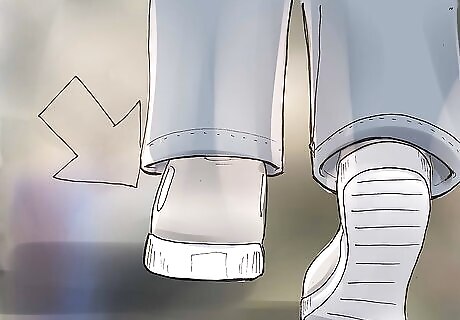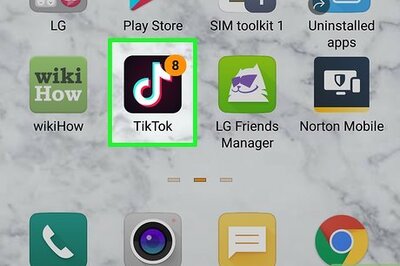
views
X
Research source
While this process may sound complicated, building out your own business process model is simple if you follow the right steps.
Preparing to Make the Model

Define the process you are modeling. Whatever process you are measuring, just be sure that it can be easily split into clear parts with easy-to-identify relationships between them. The process can be simple, like the redirection of a customer complaint, or complex, like the entire order and shipping process for an online product. Also, it may involve one department or business organization level or several of each. Make sure you choose a process in your business operation that has a clear starting point and output. For example, you might model the process of receiving an online order and checking whether or not the customer has the money to pay for it and if the item is in stock.

Identify the starting point of the process. Any process requires a first step, which can realistically be anything. However, the starting point of a business process should be what raises your process to action. In other words, it is the input that the business seeks to convert into an output. Starting points generally fall into one of several categories: External events. These include the initiation of a transaction or a transmitted alert from another business system. For example, a problem in automated system that requires human attention is an external event. Content arrival. For content management systems, the starting point might be the arrival of a new document or other form of content. Human intervention. This includes customer complaints and other human intervention within or outside of the business. For the previous example, the starting point is the receipt of a customer order.

Separate the different steps in the process. On the most general level, you will have events (steps that require no action by the business), activities (performed by the business in response to input), and decision gateways (splits in the process where the path of the process is decided by some qualifier). Between these objects, there are connectors. In traditional business process modeling notation (BPMN), the steps are represented by different shapes depending on their function. Events are circles, activities are rectangles, and decision gateways are diamonds. Connectors can either be solid arrows (activity flow), or dashed (message/information flow). For the previous example, we would use steps such as "customer order" (an event), "process order" (an activity), "Check credit" (an action), "Credit?" (a decision gateway that leads to one of two other actions, depending on a "yes" or "no" determination), and so on.

Clarify who or what performs each step. Determine which individual or part of your business is responsible for each step in the process. In BPMN, the associated person or department for each activity is either denoted by a designator next to the step or by a "pool," a horizontal division in the flow chart that shows which part of the business performs each step. Pools may be further divided into "lanes," which give more specific information about who's responsible for that step. For the step "Check credit" in the previous example, you might write that the action is performed by the business's online retail platform, for instance.

Decide which type of modeling to use. BPMN can take many forms, from sequential modeling to causation model. It can also be done using anything from specialized software to post-it notes or a whiteboard. Choose which method works best for working with your process model. These models usually work best with group input, so you may be better off using the type of modeling that can be worked on most easily by the group.
Creating an As-Is Model

Make sure you can rearrange parts as needed. When you are creating your model, make sure you can move around each step as necessary. You may find that some parts of the model can be consolidated, moved around, and reordered to make the system flow more effectively. Make sure also that the labels associated with each step, if any, can be moved easily with the step.

Start with the beginning of the process and follow the sequence. Put the starting point of the process at the top left of your model. Then, add each subsequent step, including decisions between them. Continue until you have reached the output of the business process. For the previous example, your steps might be as follows: Customer order (event) to process order (an activity) to check credit (an activity) to credit? (a decision gateway). If the customer's credit doesn't check out, you would move to the step contact the customer (activity), labeling the arrow between the steps with a "no" label. Then, you would move to cancel the order (activity). If the customer's credit checks out (a "yes" response), you would move on to check stock (activity) and connect the steps with an arrow labeled "yes." Then, you would check the stock in the decision gateway labeled as "stock?". If the item is in stock, label the arrow "yes" as before and send the order to shipping (an activity). If the item is not in stock, you would move to contact the customer and cancel the order (both activities).

Check your model. First, look over your model with a coworker or a group. Examine it for any potential holes or missed steps. Then, follow the actual business process and compare it to your model. Alternately, you can run the model in a focus group or meeting to see any steps that don't flow or are left out.

Identify inefficiencies or problems. Once you've run through your model to make sure that it works, start looking over it again to locate areas where resources aren't being used efficiently or where communications or steps that need to happen are not completed. Again, having a coworker or a group of coworkers present to help you with this adds to your ability to find these issues. For the previous example, you may realize that the process fails to let customers know that the item may be back in stock soon. This cancels the order that could otherwise be fulfilled within a number of days.
Designing the To-Be Model

Brainstorm improvements to the as-is model. Common fixes to issues include automation, geographical coordination, and removing middlemen. Automation may help you reduce resources or time required for a step. Geographical coordination can include outsourcing steps for reduced cost or efficiency. Cutting out middlemen involves reducing the number of participants in the process to reduce the chance of miscommunication or cut costs. Other areas for locating improvements may include: Informational: measuring more data regarding the process to find issues. Sequential: rearranging steps. Tracking: helps you monitor process progress. Analytical: improves decision-making at decision gateways. For the previous example, you could think about implementing a system for checking when an out-of-stock item will be back in stock and alerting the customer to an estimated delivery time.

Identify how improvements will help the business or the customer. Before implementing a new system based on your improvements, make sure that the improvements actually help either the customer or the business, or both. Making a change just because you can may result in unnecessary additional costs or more process mistakes.

Build the to-be model. Convert your suggested improvements into steps and place them in your previous model. For the previous example, this might include creating an activity step to check whether the item will be in stock soon. This would be placed before the "contact customer" activity, and the output would be to let the customer know when the item will be shipped and that it will be later than expected.

Implement the new model. Test the model using the previous method and then implement it in your business. Make sure to test it regularly and reassess it for inefficiencies and issues.



















Comments
0 comment